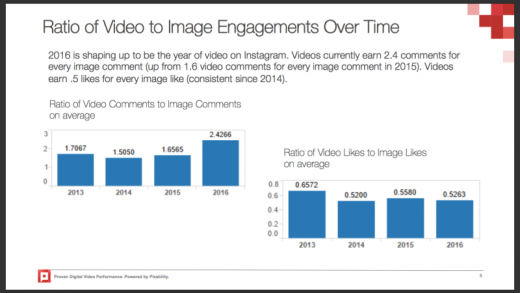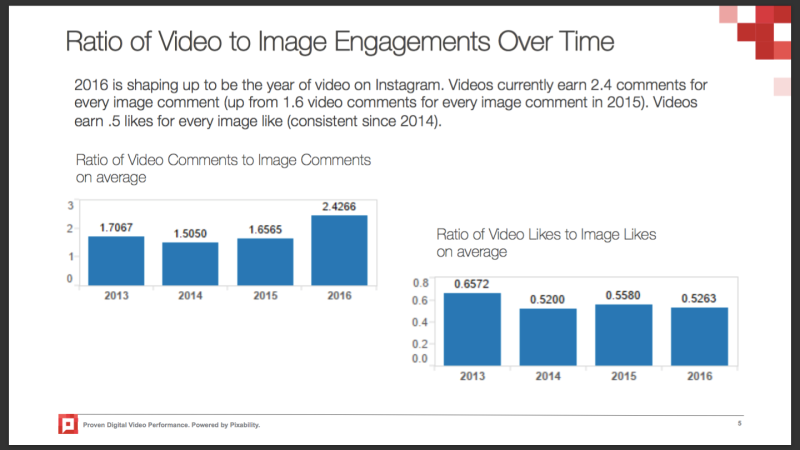Instagram Video Slowly positive aspects Traction amongst brands After three Years
manufacturers are slowly posting extra videos to Instagram, however agency professionals nonetheless say the fb-owned app is not made for video.
Instagram started letting folks publish videos in June 2013. In October 2014, it rolled out its first video ads. but even now — just about three years for the reason that first videos were uploaded to the fb-owned app — video continues to be a brand new layout for manufacturers on Instagram, person who’s rising in hobby but restricted in adoption.
On average, manufacturers posted 50 p.c more organic videos per day in January 2016 than they did in January 2015, in keeping with information accrued by way of video ad-tech firm Pixability. the company analyzed 50 Instagram debts run with the aid of manufacturers including Mercedes-Benz, Bud mild, Pepsi, Skittles, Taco Bell and Ford. however — and it’s an enormous however — manufacturers are nonetheless posting approach fewer movies than photographs. In January 2016, the entire manufacturers that Pixability examined combined to post, on average, four.06 movies and 44.16 photos.

Courtesy Pixability
“Instagram really is a ‘seem to be, like and swipe’ platform… folks go have a look at these footage, like, swipe and move on,” said John Baker, chief information scientist at Pixability.
It’s not like people are towards looking at movies on Instagram. The amount of time folks spend watching movies on Instagram has increased by using greater than forty p.c during the last six months, according to an Instagram spokeswoman.
however entrepreneurs are slow to look Instagram as a video platform, specifically as a result of Instagram doesn’t truly look like a video platform. Instagram is “really designed for an awfully quick scroll habits and no longer taking the time to actually cease and watch something. That’s under no circumstances an existing habits,” said Tara Marsh, international head of content material at Wunderman, whose shoppers include United, very best buy and Coca-Cola.
“With extra folks spending time on other systems to watch video like YouTube and Snapchat, I don’t think that’s what they go to Instagram for,” mentioned Jenny Marder, senior social strategist at pink Tettemer O’Connell + partners, which works with manufacturers like Planet fitness and MorningStar Farms. “When any individual’s going to observe a YouTube video, they’re going to have their headphones on. With Instagram it’s just really easy to scroll via no matter the place you are; video provides the facet of wanting to listen to it and concentrate and it’s just an extra step where you lose that sense of one thing being instant.”
Instagram’s guardian firm, facebook, faced the identical criticisms early into its personal video push, which began to really ramp up in 2014. As of November 2015, facebook claimed it used to be generating eight billion video views a day. That’s a squishy number, taking into account fb counts a view after a video has performed for a minimum of three seconds, however it’s nonetheless an enormous sufficient quantity to signify facebook may be very much a video platform, although videos on fb through default play with the hold forth, as they also do on Instagram.
however there’s a major difference between facebook’s video experience and Instagram’s. in contrast to fb — or YouTube or Twitter or Snapchat — Instagram doesn’t let people watch movies in full-reveal mode. instead, the movies are squished into the identical house inside the feed the place pictures seem. that means a widescreen video — the sort shot to be considered on large monitors — normally takes up less than half of the available screen area on Instagram, with no capability to zoom in or tap to make bigger the shot. That scrunched viewing experience now not most effective hampers manufacturers’ hobby in organically posting videos to Instagram but in addition paying to run these videos as advertisements.
“if they want to promote a 60-2d video advert, it must grow to be a much more immersive expertise. You see facebook doing a actually good job of that; I’m certain they’ll carry some of that to Instagram,” stated Ms. Marsh. “I don’t assume that they will in reality be capable to reach using large dollars on 60-2nd purchases unless they alter that.”
however although Instagram still isn’t made for observing movies, videos from manufacturers aren’t unwelcome. in fact, the movies brands submit to Instagram obtain 2.four instances more feedback, on reasonable, than their photos — however best half of as many likes — according to Pixability.

Courtesy Pixability
It’s uncertain precisely why people are extra more likely to touch upon a model’s Instagram video than a photograph, however listed below are two theories.
First, the more time folks spend with a piece of content material, the more likely they are to engage with it in a deeper means. “if you happen to watch a video, you’re so invested in it that likelihood is you’re going to comment on it,” Ms. Marder mentioned. And Ms. Marsh concurred. “If the content may be very immersive, you then’re more prone to get to some extent where you if truth be told have an opinion on it,” she mentioned.
2nd, Pixability’s knowledge may indicate that people are extra likely to share movies than images on Instagram. Instagram didn’t supply a share button for folk to send someone else’s images or videos to pals on Instagram except September 2015. however means prior to then, folks had found a workaround by using tagging their pals within the comments of the posts they wished to share, which might alert those pals to the picture or video that person wanted them to take a look at. When Instagram added its share button ultimate 12 months, one in every of its pros advised TechCrunch that 40 p.c of the feedback individuals go away on photos tagged other customers.
whether or not or no longer the comment figures inspire brands to accelerate their adoption of Instagram video — and whether or not or now not Instagram improves the video viewing experience — Instagram seems to be taking a web page from its guardian company’s playbook to compel manufacturers, publishers and people to put up movies to its app. remaining month, Instagram said it will begin publicly displaying how many times a video has been seen, a move that facebook took in September 2014 and that can have contributed to the social community’s booming video business. That quantity might appeal to manufacturers discouraged with the aid of the lower number of likes their movies acquired in comparison with their photographs.
“this is Instagram’s means of providing a metric that they be aware of is naturally going to be greater in order that if you say ‘Oh, it didn’t get that many likes however this many individuals noticed it,’ it’s a lot more enticing,” Ms. Marder said.
(Some photography used beneath license from Shutterstock.com.)
marketing Land – web marketing news, methods & guidelines
(38)
















